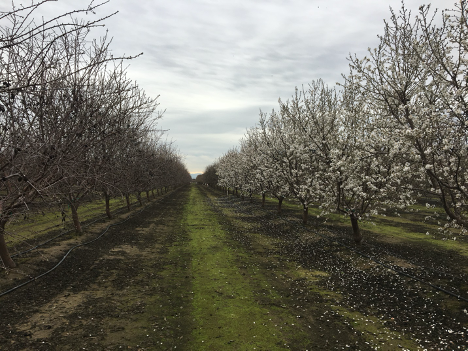
University of California personnel have been involved with evaluating new fruit and nut crop varieties from public and private breeders for over 100 years. These evaluations have always been done in partnership with commercial and public operators and we want to extend a heartfelt thank you to our cooperators for hosting these trials. We also thank the Almond Board of California for funding important research into varieties for many years.)
The most recent regional evaluations, sponsored by the Almond Board of California, were planted at three sites down the Central Valley in winter 2014. The three locations were CSU Chico University Farm in Butte County, an orchard near Salida in Stanislaus County, and an orchard near Chowchilla in Madera County. The three sites have different spacing and rootstocks (See Table 1), depending on grower preferences and rootstocks that are typical in that area. The trial was designed to allow statistical analyses of yield; each variety is planted in twelve-tree stretches and repeated four times at a site in a random order. In other words, each site has 44 to 48 trees of each variety, split up into groups of four and randomly planted next to other varieties, with a Nonpareil row on either side.

Trial Limitations
Before reading further, it is important to understand the limitations of these regional variety trials. This is a rigorous examination of traits like bloom timing, the initiation of hull split, and yield. However, there are limitations related to evaluating dozens of different varieties in the same field. The trees vary widely in size, shape, light interception and yield, resulting in different irrigation and fertilization needs. Smaller-statured varieties may have lower yields compared to larger trees and may look better at a site with closer spacing.
Because our cooperators cannot economically perform different bloom and hullsplit sprays to ensure optimal coverage for each variety and fertilize each variety based on its yield, the varieties cannot be perfectly managed. Traits like navel orangeworm (NOW) damage, though largely influenced by shell seal (which is a varietal trait), should be viewed with a grain of salt as the nuts of a variety may remain on a tree a week longer than is ideal if there are not enough varieties ready to justify a harvest. However, if certain issues are constant through all three sites, it is more likely to be an issue with the variety rather than the impossibility of perfectly managing all of the varieties.
We always recommend that you use as much information as possible when deciding what variety to plant. Evaluate UC variety trial data as well as input from nursery representatives, handlers, neighbors and your personal experience. Some issues with new varieties may not appear for many years or until they are planted on a wider scale. At this point in the trial, while we are looking for varieties that perform well, we are primarily identifying ones that have such major issues that they will not be acceptable for wide-scale planting.
Public and private breeders were invited to submit varieties they had released recently or were interested in releasing. Independence and Shasta could not be included in the variety trials. Table 1 indicates which varieties are self-fertile or self-sterile. Self-fertility is when the flower is receptive to pollen from the same or a closely related variety, but some bees may still be needed to consistently get pollen from the anther to the stigma. Self-sterile varieties (such as Nonpareil) require pollen from a different variety to set a commercially acceptable yield and added beehives during flowering to ensure cross-pollination.
The trials were planted so that each row of pollinizers was adjacent to a row of Nonpareil. Because of this, these variety trials cannot fully assess the yield potential of the partially or fully self-fertile varieties as if they were planted in solid blocks. Due to the enormous amount of data this trial generates, we will present the accumulated data and note when a year may have had an exception.
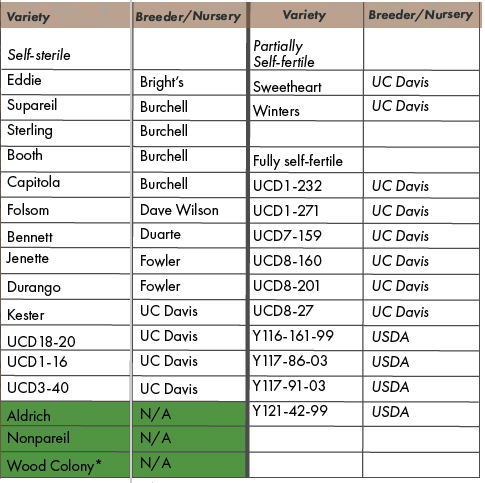
Bloom Data
We measure bloom progression by recording the dates of 1% bloom, full bloom (when 80% of the flowers are open) and the end of petal fall. Varieties that are good pollinators for Nonpareil should overlap closely with it (See Tables 3 and 4), though many growers will plant other varieties that may bloom a bit before or after to account for unusual bloom conditions. In most years, UCD 3-40 blooms much earlier than all other possible pollinators so yield data does not reflect the yield potential of this variety.
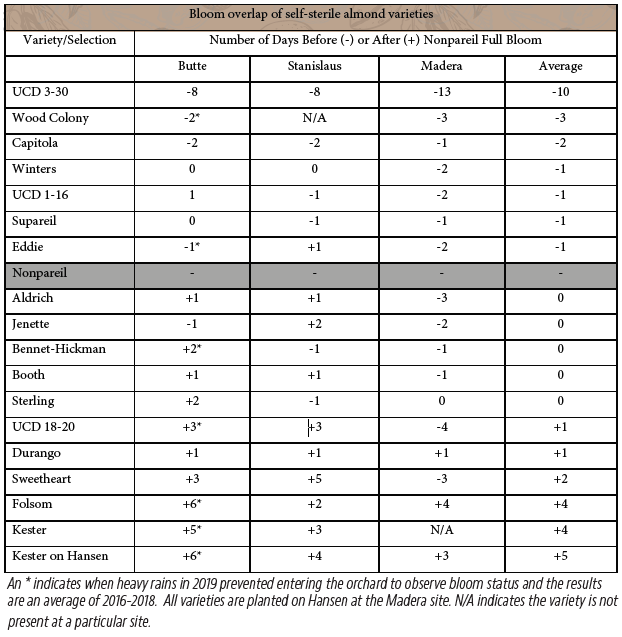
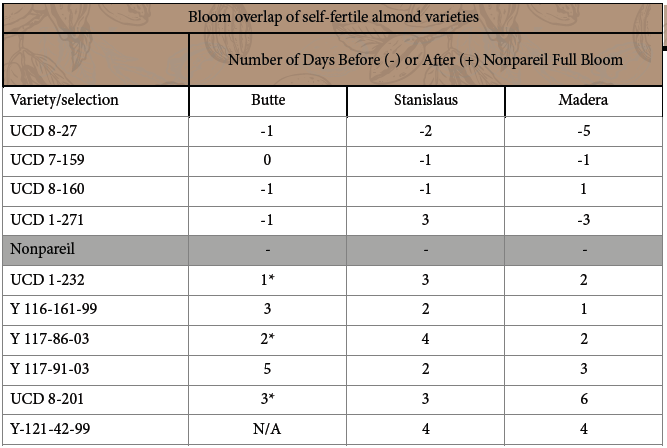
Disease, Death and Other General Observations
Gopher damage has been present at both the Butte and Madera sites. At the Butte site, gophers have particularly targeted the Hansen rooted trees (Kester on Hansen rootstock) and there have been many tree deaths. Gopher girdling has killed several trees at the Madera site, where all trees have been planted on the Hansen rootstock, but deaths have been scattered across varieties and likely do not significantly affect yields. Some diseases, such as bacterial blast, have occurred at several sites over several years (See Table 5).
A more significant concern at the Madera site is a spot with poor drainage that has resulted in several tree deaths and poor establishment of replants, affecting Winters, UCD8-160 and Wood Colony. The Madera site also has three different soil types that are resulting in vigor and hullsplit and harvest timing differences; trees in one soil type (a Class II soil) have the highest vigor and complete hullsplit several weeks after trees growing in a Class I and Class IV soil. Trees growing in the Class I have intermediate vigor, and those in the Class IV have the lowest. Hullsplit ratings are mostly relegated to trees in a single soil type, but the differences in hullsplit timing result in harvest delays for trees growing in the Class I and Class IV soil types.
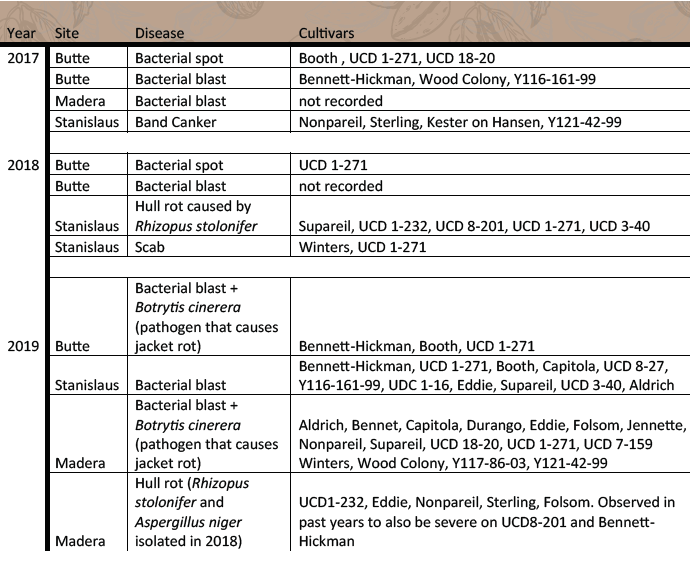
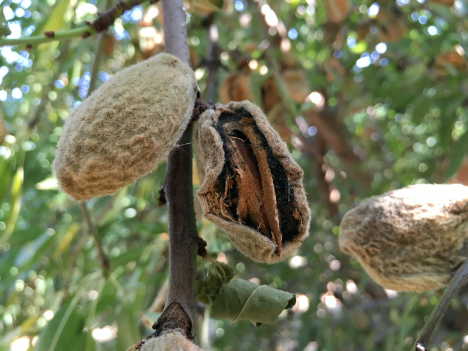
In both 2017 and 2018, low hive strength likely reduced yields at the Butte site. There was also a frost event in 2018 that affected both Madera and Butte. At the Madera site, low temperatures on the 20th, 21st and 24th reached 25, 28 and 24 degrees F, respectively. At the Butte site, low temperatures on the 19th, 20th, 22nd, 23rd and 24th reached 26, 28, 29, 28 and 26 degrees F, respectively.
Hull split
Knowing when a variety enters hullsplit is important for timing NOW sprays (See Table 6). The end of hullsplit (when the suture of all nuts has split open) indicates when the variety can be harvested. The nuts must be protected from NOW between the initiation of hullsplit and harvest; varieties that are in hullsplit for more than 14 days may require a second spray, depending on the residual protection time of the product used. It is wise to select pollinators for Nonpareil that have a hullsplit end date that does not overlap with Nonpareil. Most processors offer lower prices for mixed nuts, and close harvest dates may increase the risk for mixing. In 2018, the later maturing varieties at the Madera site were shaken earlier than desired. This did not affect yield but did result in a loss of hullsplit data.
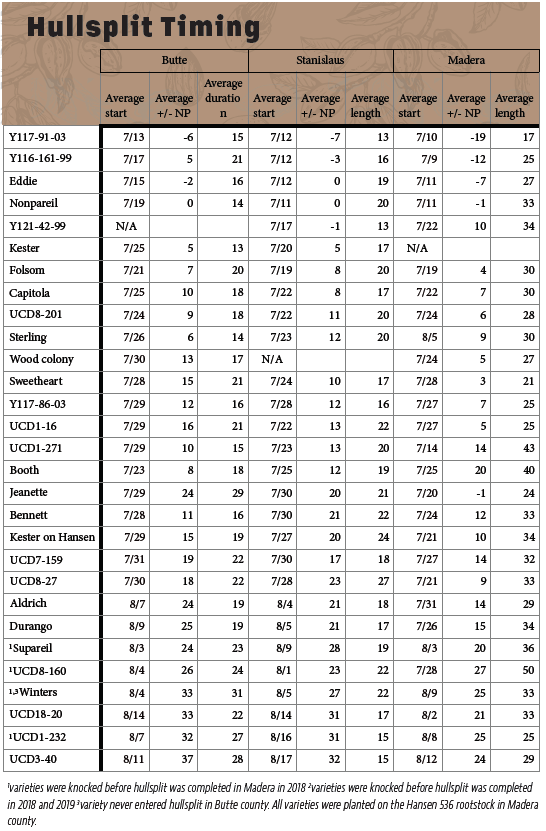
Yields
Yields for the first four years are presented (See Tables 7, 8 and 9). We emphatically do not recommend basing variety selection on four years of yields. Some varieties do not start bearing heavily until maturity, while others do not show fatal flaws until maturity. While the sites also have different spacings, this should not be used as a referendum on spacing, as there have been events that have negatively affected yields at certain sites. The Butte site, for instance, has had low beehive strength, particularly in 2017 and 2018, likely reducing yields. In 2017, the Stanislaus site suffered from a springtime drift injury of glyphosate and glufosinate which damaged trees and reduced yields. Many trees of some varieties have been killed from band canker as well (See Table 5). Early yields are unreliable when determining ultimate yield potential, so we have not yet dropped varieties based on low yields.
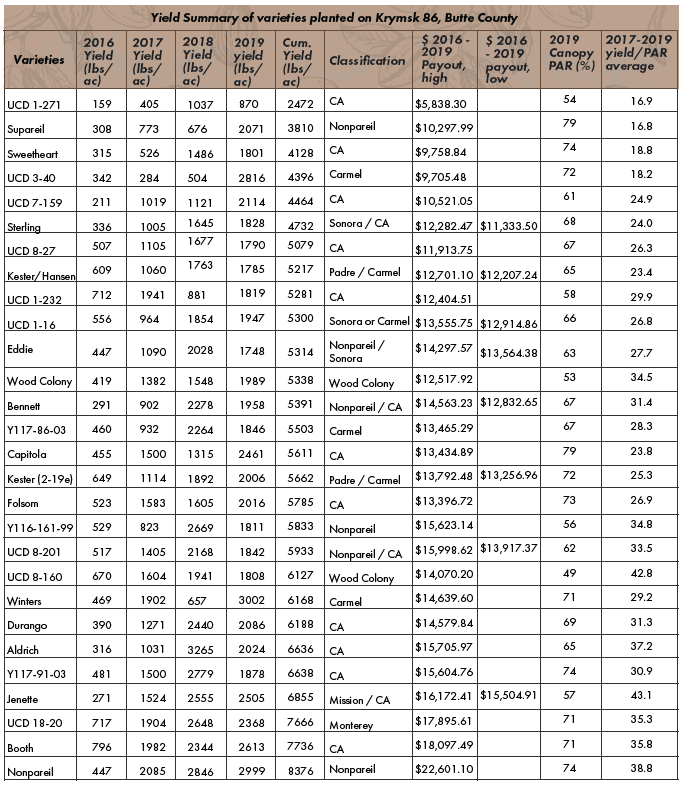
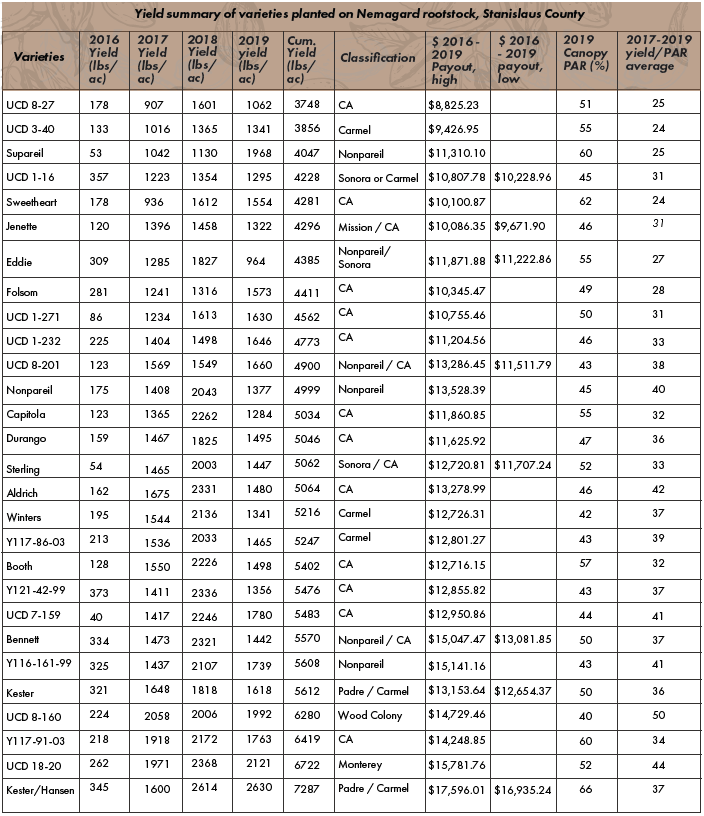
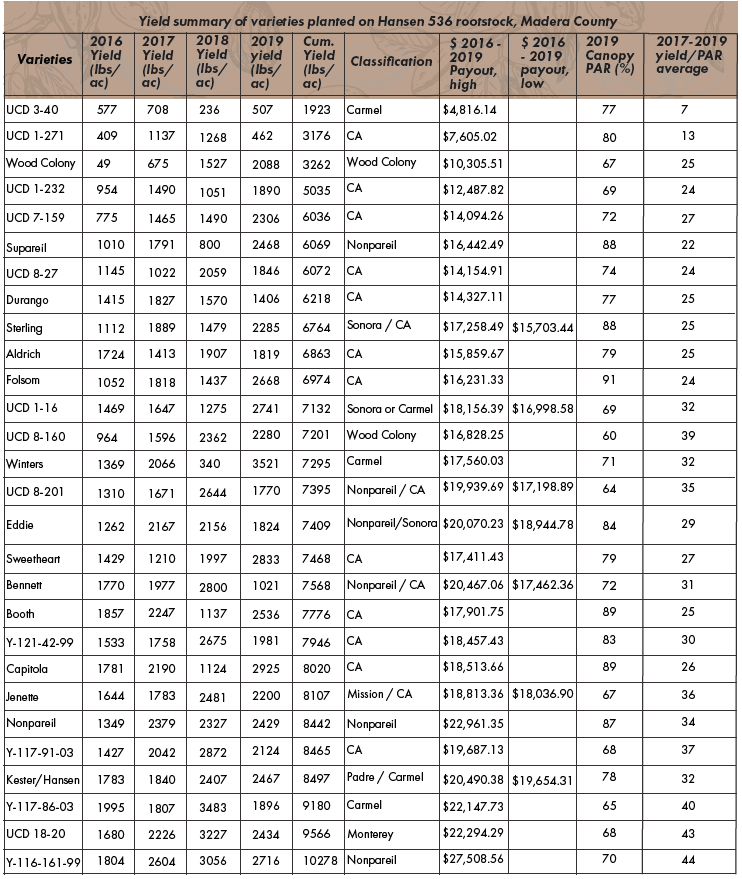
Photosynthetically active radiation (PAR) is the percentage of light interception a variety captures. It has been found to correlate with yield potential, especially at sites that do not have other significant disease or management issues. PAR can be taken as an indication of vigor during establishment years, however as discussed below, high vigor and high PAR interception do not necessarily translate to higher yields.
We are using yield/PAR as an indicator of tree efficiency, or how many pounds of nuts trees produce per percent canopy cover. We are presenting the 2017-2019 average for this variable as another indicator of a variety’s yield potential. A tree that is naturally small but yields well for its size may look worse than a larger tree when looking at yearly or cumulative yield, but may have similar yield/PAR values. That small tree may perform better when spaced more closely. Additionally, the industry is exploring off-ground harvest technologies to reduce dust. Orchards that already use off-ground harvesting technology perform better when trees are smaller. In these systems, small trees with high yield/PAR values may be valuable. Low yield/PAR can also indicate an issue during bloom, such as excessively wet conditions, severe bacterial blast or frost events, thus it is important to examine several years of data.
Defects
Defect data includes horticultural (double kernels, twin kernels) and insect issues (NOW damage) (See Table 10). Due to the difficulty in adequately protecting all the varieties with different hullsplit dates, issues such as NOW damage should be viewed with a grain of salt, though those that have consistently high damage across a site may be of concern. Three UCD selections, 18-20, 8-201 and 1-16, have high rates of double kernels across all sites, and UCD 3-40 and 8-27 had high rates of doubles across all three sites. The threshold of reporting varieties with defects greater than 6% has no significance; this threshold was chosen to simplify the results.
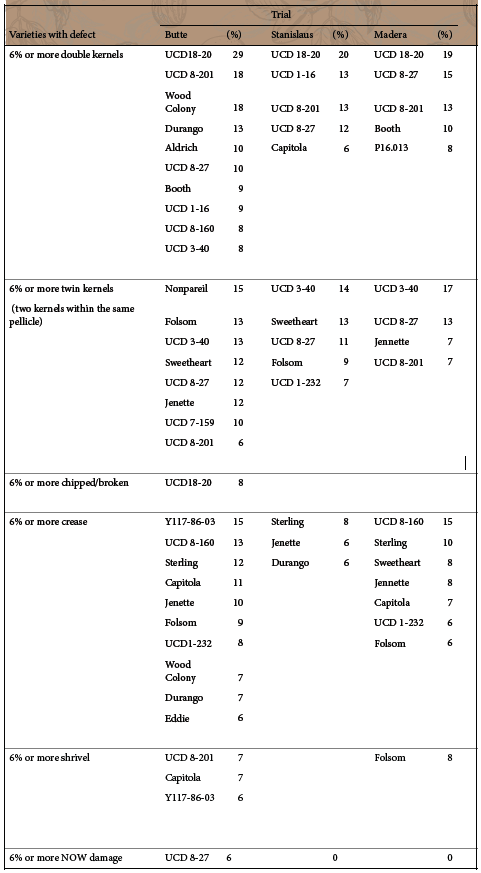
Conclusions
These trials are ongoing and will continue for a few more years. At this point, we can eliminate some new selections with issues that make them unsuitable for commercial production. On the other hand, there are some commercial and experimental varieties that appear to be high performers and are worth exploring further. New regional trials will be established in the future to continue the search for high quality, high yielding varieties, with a special emphasis for those that are self-fertile.










